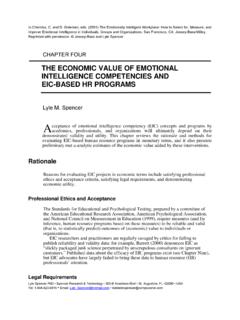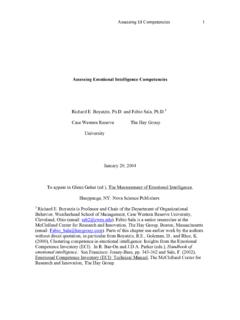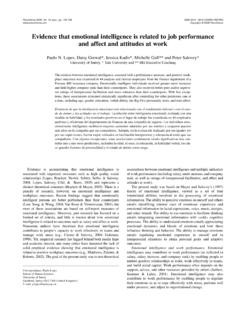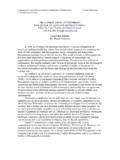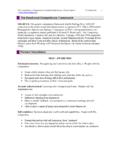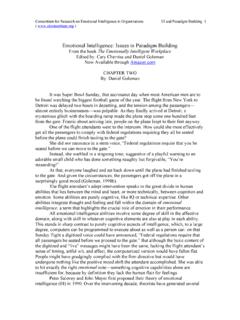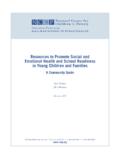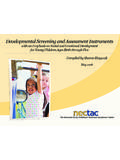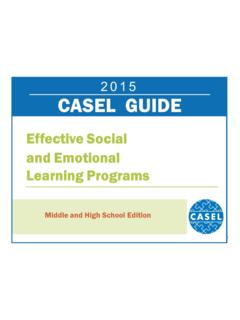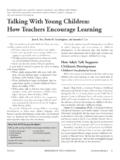Transcription of Original Reference Bar-On, R. (2006). The Bar-On …
1 Consortium for Research on emotional Intelligence R. Bar-On The Bar-On Model of emotional - social in Organizations Issues in emotional Intelligence 1 The Bar-On Model of emotional - social Intelligence (ESI)1 Reuven Bar-On University of Texas Medical Branch Original Reference Bar-On , R. (2006). The Bar-On model of emotional - social intelligence (ESI). Psicothema, 18, supl., 13-25. emotional intelligence has become a major topic of interest in scientific circles as well as in the lay public since the publication of a bestseller by the same name in 1995 (Goleman). Despite this heightened level of interest in this new idea over the past decade, scholars have been studying this construct for the greater part of the twentieth century; and the historical roots of this wider area can actually be traced back to the nineteenth Publications began appearing in the twentieth century with the work of Edward Thorndike on social intelligence in 1920.
2 Many of these early studies focused on describing, defining and assessing socially competent behavior (Chapin, 1942; Doll, 1935; Moss & Hunt, 1927; Moss et al., 1927; Thorndike, 1920). Edgar Doll published the first instrument designed to measure socially intelligent behavior in young children (1935). Possibly influenced by Thorndike and Doll, David Wechsler included two subscales ( Comprehension and Picture Arrangement ) in his well-known test of cognitive intelligence that appear to have been designed to measure aspects of social intelligence. A year after the first publication of this test in 1939, Wechsler described the influence of non-intellective factors on intelligent behavior which was yet another Reference to this construct (1940).
3 In the first of a number of publications following this early description moreover, he argued that our models of intelligence would not be complete until we can adequately describe these factors (1943). Scholars began to shift their attention from describing and assessing social intelligence to understanding the purpose of interpersonal behavior and the role it plays in effective adaptability (Zirkel, 2000). This line of research helped define human effectiveness from the social perspective as well as strengthened one very important aspect of Wechsler s definition of general intelligence: The capacity of the individual to act purposefully (1958, p.)
4 7). Additionally, this helped position social intelligence as part of general intelligence. The early definitions of social intelligence influenced the way emotional intelligence was later conceptualized. Contemporary theorists like Peter Salovey and John Mayer originally viewed emotional intelligence as part of social intelligence (1990, p. 189), which suggests that both concepts are related and may, in all likelyhood, represent interrelated components of the same construct. 1 For a number of years, I have referred to this construct as emotional and social intelligence which I have recently abbreviated to emotional - social intelligence.
5 2 It was Charles Darwin who published the first known work in the wider area of emotional - social intelligence as early as 1872 (on the importance of emotional expression for survival and adaptation). Consortium for Research on emotional Intelligence R. Bar-On The Bar-On Model of emotional - social in Organizations Issues in emotional Intelligence 2At about the same time that researchers began exploring various ways to describe, define and assess social intelligence, scientific inquiry in this area began to center around alexithymia (MacLean, 1949; Ruesch, 1948), which is the essence of emotional - social intelligence in that it focuses on the ability (or rather inability) to recognize, understand and describe emotions.
6 Two new directions that paralleled and possibly evolved from alexithymia were psychological mindedness (Appelbaum, 1973) and emotional awareness (Lane & Schwartz, 1987). Research exploring the neural circuitry that governs emotional awareness (Lane, 2000), as well as additional emotional and social aspects of this concept ( Bar-On et al., 2003; Bechara & Bar-On , in press; Bechara et al., 2000; Damasio, 1994; Lane & McRae, 2004; LeDoux, 1996), has begun to provide tangible evidence of the anatomical foundations of this wider construct which some have questioned as an intangiable myth (Davies et al., 1998; Matthews et al.)
7 , 2003; Zeidner et al., 2001). The literature reveals various attempts to combine the emotional and social components of this construct. For example, Howard Gardner (1983) explains that his conceptualization of personal intelligences is based on intrapersonal ( emotional ) intelligence and interpersonal ( social ) intelligence. Additionally, Carolyn Saarni (1990) describes emotional competence as including eight interrelated emotional and social skills. Furthermore, I have shown that emotional - social intelligence is composed of a number of intrapersonal and interpersonal competencies, skills and facilitators that combine to determine effective human behavior (1988, 1997b, 2000).
8 3 Based on the above, it is more accurate to refer to this construct as emotional - social intelligence rather than emotional intelligence or social intelligence as I have suggested for some time (2000). Throughout this article, I will refer to this wider construct as emotional - social intelligence ( ESI ). Since the time of Thorndike (1920), a number of different conceptualizations of ESI have appeared which have creating an interesting mixture of confusion, controversy and opportunity regarding the best approach to defining and measuring this construct. In an effort to help clarify this situation, the Encyclopedia of Applied Psychology (Spielberger, 2004) recently suggested that there are currently three major conceptual models: (a) the Salovey-Mayer model (Mayer & Salovey, 1997) which defines this construct as the ability to perceive, understand, manage and use emotions to facilitate thinking, measured by an ability-based measure (Mayer et al.)
9 , 2002); (b) the Goleman model (1998) which views this construct as a wide array of competencies and skills that drive managerial performance, measured by multi-rater assessment (Boyatzis et al., 2001); and (c) the Bar-On model (1997b, 2000) which describes a cross-section of interrelated emotional and social competencies, skills and facilitators that impact intelligent behavior, measured by self-report (1997a, 1997b) within a potentially expandable multi-modal approach including interview and multi-rater assessment ( Bar-On & Handley, 2003a, 2003b). The purpose of this article is to present, describe and examine the Bar-On model of emotional - social intelligence (ESI).
10 This is an empirically based theoretical paper. As 3 This work began in the early 1980s as part of my doctoral research (1988). Consortium for Research on emotional Intelligence R. Bar-On The Bar-On Model of emotional - social in Organizations Issues in emotional Intelligence 3such, various findings are presented to describe this theory of ESI and demonstrate that it is a comprehensive, robust and valid conceptualization of the construct. The first part of the article describes the Bar-On model and measure of emotional - social intelligence and how it was developed. The second part provides the reader with a description of the model s construct validity, and the third part describes its predictive validity.

